Montage of four images of Comet 67P/C-G taken on 26 September, from a distance of 26.3 km from the centre of the comet. The four 1024 x 1024 pixel images making up the montage are provided at the end of this post.
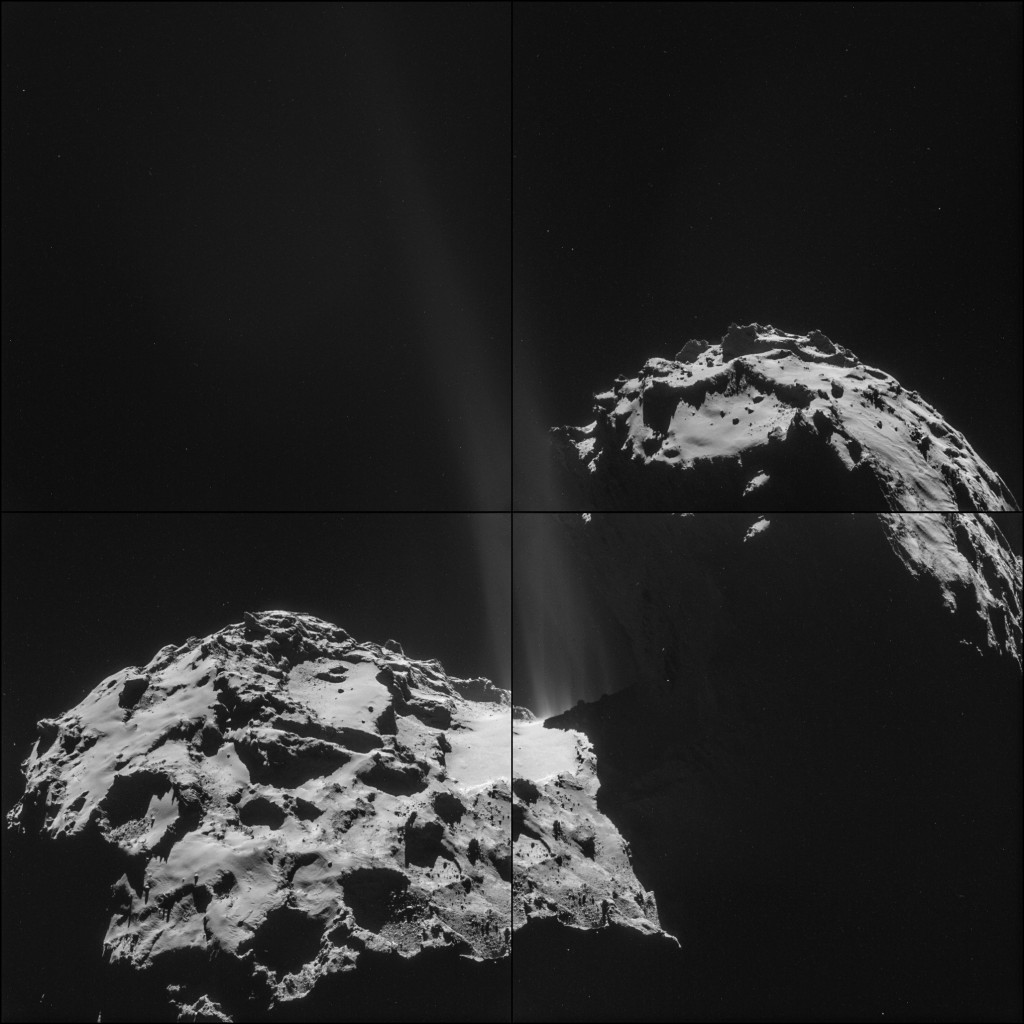
Four image montage of 67P/C-G on 26 September from a distance of 26.3 km. Credit: ESA/Rosetta/NAVCAM
The individual images have been background subtracted to remove some striping and fixed noise patterns. In making the montage, the background levels have then been adjusted in order to make the images more or less equivalent, the vignetting in the corners of the images has been reduced, and some processing of the overall brightness and contrast has been applied using Adobe Lightroom. Finally, the montage has been rotated by 180°.
We have not made a proper mosaic on this occasion, because it is becoming extremely difficult at these close distances due to the combined effect of the comet rotating between the first and last images taken in the sequence (about 10 degrees over 20 minutes) and the spacecraft moving by some 1–2 km in the same time.
While the two images on the right of the montage could perhaps be joined seamlessly, the problem becomes much harder between the lower-right and lower-left images. Careful inspection makes it clear that the perspective has shifted considerably between them and that some of the shadows have changed a lot as well.
It’s not easy to bring these images into alignment and thus we leave the challenge of making a reasonable mosaic from them to you!
That aside, it goes without saying that the main talking point of this image is the spectacular region of activity at the neck of 67P/C-G. What we’re seeing is the product of ices sublimating and gases escaping from inside the comet, carrying streams of dust out into space. Zooming in close to the surface and to the source of this activity and it is apparent that it is originating from several discrete locations.
You might also like to try increasing the exposure of the montage to bring out some faint details of the comet’s ‘head’, and even some boulders in the neck region.
As the comet gets progressively closer to the Sun along its orbit, the surface will become warmer, and the level of activity will increase, producing a vast coma around the nucleus, along with a tail. It’s perhaps hard to believe looking at images like this at less than 30 km distance from the surface, but recent ground-based images have revealed that 67P/C-G’s coma already extends at least 19 000 km from the nucleus!

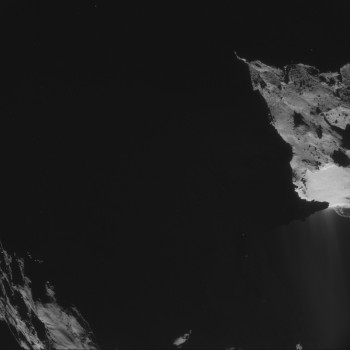
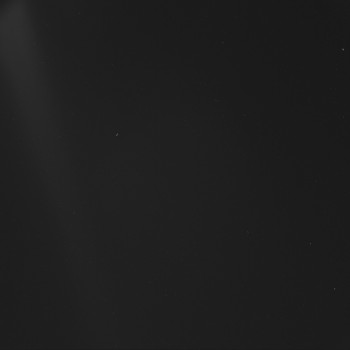
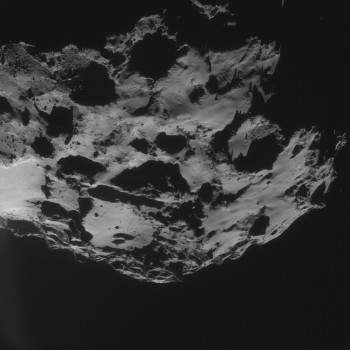
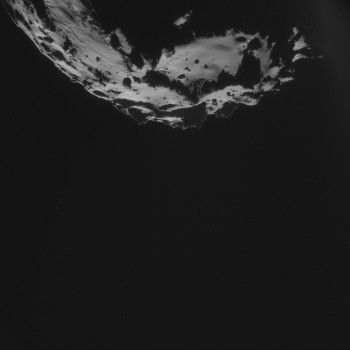








Discussion: 49 comments
Another sporadic outburst always from the same region. Its origin from deep inside due to the 350000000 N pressure in this zone accentuated by tidal effect. Virgin vapor and dust from the deep inside of the comet entering space and made accessible for the instuments on board Rosetta and Philae to analyze, thats a spoiler if anything is and i hope someone at ESA is using this opportunity to the full. If not yet thought of then here is the hint!
Impressive photos again. Thanks a lot.
One Question on the cometary activity:
Can it be put in numbers how large
the difference in activity is between
early August and now (early October)?
Ingo.
Its the second of October and this picture is from the 26 of September. What is the reason to such a delay. Must the images pass instances of censorship and are those overwhelmed with workload? You can leave image processing to the audience as there are quite a few persons that does this very well and are sharing , if images are released faster we will be a lot happier. Also a note of a technically qualified person should leave a comment containing data of essence like an estimate of its escape velocity, its mass and its development over time meaning for how long has it been exhausting. The figures only need to be an estimate and not belong to some proprietary this and that blocked information.
Thank you for today’s wonderful images! This fits into an explanation I’m working on for the source of these north polar jets– or it may sink my theory, we’ll see 🙂 .
More later today…
–Bill
Over 90% of the information in this post is about the image processing, to my understanding this is of no interest for this audience. Four lines can be read about the real thing this image is about and in those four lines not much of essence is delivered. Please add information of how long the outburst has lasted, a time / activity-scale would be nice to have. Is it in the plane of rosettas orbit? How fast is it leaving the comet? More or less then 10 meters per second? This is the kind of information this audience likes to read about. If a sublimation process actually is on scene then this is a confirmation that the energies released in the neck region due to structural changes are immense. The figure at least 19000 km Coma is very old information and should, if noted, be updated at a rate of once every 3 month. If i say it is about 50 000 km that to is at least 19123 km.
Do any of you knows what is an ITA?
One more centerfold image trying to show almost everything but still hiding away the sweet parts.
I have an urge to see the origin of the outburst, is this a perversion of mine or is it to be considered as normal?
To fill a post with bread text is not needed as the audience only is interested in one single simple thing.
Somebody at the source of information and with and academic background Is expected to deliver information containing essence.
Nice Pictures, have you any with better resolution.
Well I can see the interesting jets from the neck, but so far cannot make the leap to say its sublimating gases from inside the Comet.
Are there any photos from another part of the orbit that axctually show the ground that the jets are coming from while the jets are activated.
The 2 pictures would then be extremely interesting. Currently this does not show much more than pictures of the jets taken at 90km accept for we have more dtail of the comet features.
A picture showing the ground where the jets are active at an angle that also allow us to see the jet must be in your data set. please could we see something like that.
Also were any pictures possible from the dark side, showing hot spots? if indeed there were any.
If not maybe an infra red map of the ground that was scanned on the Dark side.
And then all the other instruments, density of comet, whats it made of, any ice detected underneath, magnetic fields, electric currents. Composition of the dust so far collected etc.
these are wonderful – can you state what the resolution is? – or rather the distance shown by the frames – I’m trying to make a scale visualization image based on the image A jpeg.
Thanks – wonderful work, been following every post..
Hi Simon, apologies for not including this information. I make it about 2 metres/pixel from this distance, so the 1024 pixel frames are equal to about 2 km across.
We will composite these images. Not because it is easy, but because it is hard.
Anaglyph image draped over shapemodel:
https://mattias.malmer.nu/2014/10/cascade-of-light/
Brilliant again Mattias. I will also plug the numerous other anaglyphs that you have done which can be found here.
https://www.planetary.org/blogs/emily-lakdawalla/2014/10020948-malmer-comet-3d.html
Thanks to the team for this image. It is the first shot of the back/south of the neck region, so from the pictures available finding the source of the streams of dust is once again open to speculation. The northern hemisphere receives a lot more sunlight, so it seems strange that this activity is in the south. Suggestions of tidal forces and internal friction being the source of energy responsible seems more plausible. In the absence of more visual evidence of the source points no conclusions can be made.
A great picture, but not very informative.
I will keep making these 3d versions. Hopefully there will be another stereo OSIRIS release at some point so that we get to see it in 3d for real. In color would be Amazing…
In the meantime you will have to do with my erzats images 🙂
I will post them on my blog as soon I get them done. Usually within a day or so after I get my hands on the new images.
https://mattias.malmer.nu/
Mattias Malmer what you do is really fantastic.
Great stuff Mattias – thanks for sharing it here, too!
Thank you for your kind words Emily!
I just try to give a little back. You guys fly the most amazing ship and I get to ride out there with you. For this I am eternally grateful.
When it comes to space imagery I like to share it as much as possible. I want everyone, especially kids, to see space as a real place. A destination that is not separate from the everyday world like some abstraction but a real physical place. A place waiting for them promising unending adventure.
The way to spread that vision and to make people not tolerate but demand space exploration is by capturing their imaginations. Image is by far the most powerful tool for that. I plan to use that tool to the best of my ability.
Mattias
keyboard slipup: images not image is the best tool…
Mattias,
You’ve done some excellent work with your visualizations of Comet 67P/C-G — Thank you for sharing them with the rest of us!
This work is brilliant and I just wanted to let you know how much your skills are appreciated. It is wonderful, top-notch work!!
Thank you!!
This is really getting spectacular. If it’s already this active i can not even imagine how active it will be a year from now!
Lets hope the spacecraft and the lander will be okay. Must be lots of dust getting into Rosetta on board the COSIMA mini laboratory by now already. By next year it will be like holding your boots in the river.
Fantastic image!!!
The comet seems to be qute active already, I guess this activity could affect Philae during descent towards Site J. Can anyone tell how accurate is Rosetta at “targeting” the comet in order to launch Philae? In one of press conferences Andrea Acamazzo stated that thuster burns are not perfect and there is a level of uncertainity if it comes to achieving the desired orbit. In my opinion it is a siginificant challenge to drop the lander from the distance of over 20km.
I wonder how long we need to wait for a 3D model file to be published – It would be great to rush off to the local 3D print shop and have our own model to hold and examine. How about it ESA ?
Not long at all, JohnM! please see today’s post to download 3D model files: https://blogs.esa.int/rosetta/2014/10/03/measuring-comet-67pc-g/
Wow, incredible image. I wish we could get a better view of the jets to directly observe these hypothetical vents which are supposed to be forming these magnificent streams. I predict that the location of these jets will move about the neck region as they etch away at the nucleus.
Very nice Picture, spektakulär !
And always, GO, rosetta….
Finally we get another image from ESA..
The reason of another of the sporadic outbursts is most likely due to the gravitational pull between the two bodies creating a force in the neck region of about 350 000 000 N. The tidal force influence due to the g- field of our sun accentuate these occasions and the internal structure is shifting now and then, partly collapsing and these small comet quakes release enough energy to create an exhaust of vapors and dust, some of the vapors frosting to ice, liquids if present will evaporate before reaching the surface level due to the almost vacuum in space. The speed of the stream leaving the comet is not told by ESA as they have no interest or competens to deliver this kind of information. Earlier outbursts show a slight twist in the stream that could be due to the comets 14 ,4 hour period angular velocity. An estimate or poor guess of this interpretation gives that the speed of the outburst is in the range of 5 to 15 m/s, so don’t call it a jet it is rather a good breeze.
ESA wants to get attention by playing on the strings of curiosity, spectacularity, and eye catchers but at the same time give away nothing of essence. The audience ESA prefers are to be found amongst the less minded, although this kind of audience looses interest quite fast.
Those who stay and are dedicated are kept on a starvation diet of poor information on a low competence level.
Its embarrassing to realize that a person with an academic background know so little about the information that should be delivered without influencing proprietary rights.
The surface of the comet is mixed up with the solar wind and what else there can be, so to get virgin material to analyze the inner layers would most likely be of uttermost interest. Philaes little drill reaches a few decimeters into the soil and what that experiment gives is a huge clue to a question mark. Several time these sporadic outbursts occur and deliver the best material samples of the deep inside of the comet ready to analyze by instrument on Rosetta and Philae. Once the outburst is in the vacuum and radiated by the sun and solar wind it will soon loose its virginity and essential information. Its time to risk a deep orbit to sniff up these rare spoilers delivered by the comet but i dont think ESA ever planed this beforhand.
The density of the stream is very low, its practically vacuum and the speeds involved of no danger to Rosetta it would not slow down its orbit noticeable if one or two passes through the stream was made.
This is an image that has been processed a lot eater to enhance or to hide information, its hard to say if particles in the stream are noise or real objects.
On one other mission it was reported that huge flakes of fluffy snow where present in the streams the size up to 30 cm was formed out of vapor of water and other frosted gases. Sublimation is the fancy word.
This material reflects as good as snow does and not as bad as the rest of the charcoal colored comet.
I wonder just how old the comet is? Wonderful pictures and science and more to come … if the lander lands softly and safely.
Does the fact that the main out gassing (at least in these amazing piccies) is coming from the waist of the comet explain its shape?
Awesome, many thanks to Rosetta team, breathtaking each image, each explanation. Thanks again.
Nice. The Life magazine money shot. Happy accident with the frame-lag, as it makes great pairing shots for cross-eye 3d stereoscopes.
My enhancement of comet 67/P from ESA/Rosetta Mission. Fantastic images. Thanks ESA. Enjoy it!!!
https://scontent-b-ams.xx.fbcdn.net/hphotos-xfp1/t31.0-8/10700414_782220905152263_4992332585559620030_o.jpg
Fantastic! Note the cloud to the left of the jet. Is it real or an artifact? Should have real fireworks in a few months. Thanks
Wanderfull picture but, as usually, only qualitative, generic and so poor interesting comments…
In a word, ESA release only informations that are
not interesting for a ROSETTA mission fans. We are
interested in seeing the real sources of the jets, the
local temperature, the composition of the jets, their
velocity, the amount of gaseus material involved, and so on. Why informations of this kind are NEVER released ?
What makes you think they already have all that information ?
Nice pictures but, once again, I deplore the slow delivery of data to general public (and always from NAVCAM as OSIRIS images are “blocked by censorship” (you know what I mean), and the lack of serious interesting scientific commentary by ESA in these posts. Simply disappointed. On the other hand, glad to know that our money is not vasted over there (well I hope so).
So who wants to explain to me why the sublimation occurs in the shade? Wouldn’t the standard model predict that any outgassing would be first produced in the sunlight?
The standard model does NOT predict outgassing in the shade. Outgassing should be in proportion to the temperature where the volatile becomes a gas. The surface temperature hot points are only roughly in proportion to insolation. The subsurface is predicted to be (and measurements back this up) colder than the surface. Since the volatiles are in the subsurface or lower, it is where the most heat gets transferred to the subsurface volatiles most efficiently. So, just broadly sunnier spots will likely have more outgassing, with plenty of exceptions.
It is clear that activity is increasing. In July we had a figure from the MIRO team of about 300ml per second as the rate of water escaping the comet. A while later that figure increased to about 5000ml/sec. Since then we have heard nothing. Nobody is asking for detailed figures, rates of change, outflow from specific spots etc., just another ball park figure would be nice.
Still no word on the overall density either, even though multiple orbital manoeuvres and detailed trajectories for the Philae landing have been announced. These can only have been calculated with a very good figure for that density. Surely this comes under the basic properties of 69P like the size, mass, albedo and orbit already announced.
At the arrival event great emphasis was placed on ESA’s prioritisation of science in its missions. Various instruments were explained simply and clearly so most people could get a basic idea of what science was being done. Many times enthusiastic statements were made about the wonderful science results we would see and be told about in the next few weeks and months. Since that event nothing except some great pictures and information about orbital manoeuvres.
Rosetta and its science team are in a position to shed light on new and unknown territory. The world is waiting with keen anticipation. There are so few unanswered or unanswerable questions left these days to satisfy the curiosity of people. Space exploration for that reason, is fascinating to everyone, not just the scientific community. The withholding of so much basic information smacks of elitism and selfishness.
I for one really have enjoyed the unpretentious, natural enthusiasm and joy members of the ESA team have shown at Rosetta public events, from both scientists and administrators. People are engaged by that. This mission has been recognised by the wider public as a great achievement and a source of pride for Europe. Yet two months after arrival we, the paying public, know essentially nothing more now about the comet than we did then. This mission is a PR goldmine for ESA and science. It frustrates myself and a whole load of other people, that so little basic information is available to satisfy the the public’s curiosity, especially since so much good work, money and effort was put in to engender public interest during the time leading up to the arrival at the comet.
So there are rules, this is a FIRST for mankind, bend the rules, break the rules. ESA is in the role of pioneer now and as such is in a position to do things differently in the internet age. Give the world some information and give us something to talk about other than ESA’s inadequacies.
You’ll find the answers to e.g. density/mass/volume etc in today’s blog post: https://blogs.esa.int/rosetta/2014/10/03/measuring-comet-67pc-g/
Much appreciated Emily. Thank You.
Thank you Emily, a late awakening is better then no one.
Glad you made a proper composition that surely fulfills the requirements of protecting ESA proprietary rights and to satisfy the public group that are keen to get more substantial information. Keep it on this level and we all will be very happy..
Best regards, Erich.
A point well made Robin. It appears though that despite the hype and the promises, despite who is paying and the great opportunity the needs of the ESA academics come first. They want to retain new and pioneering information so they can publish it fresh and enhance their reputations.
Mattias,
fabulous work also more detail in emilys blog on the link on Rob S.
The desciption of how you produced the pictures on Emilys blog was also very interesting.
Thanks for all the hard work
Our contribution on this amazing close-up view.
Not satisfied with the results obtained by the common graphics program, this time we decided to stitch and level the images fully by hand:
https://www.flickr.com/photos/lunexit/15258445997/in/photostream
As always, we played with the colors too!
https://www.flickr.com/photos/lunexit/15424494686/in/photostream
Managed to get Microsoft ICE to assemble the mosaic. I think it came out pretty good. Image further processed to remove noise and improve constrast. https://l3.picsurge.com/o9KH6W/ESA_Rosetta_NAVCAM_20140926_stitch2.jpg
I was hoping that new images of 69P would show the active jet areas, but not yet.
This is what I think is happening with the dust jet process. On thing I notice is that there is a string of “boulders” in a nice line and they are aligned with linear fractures seen on dust-free rock. Too much of a coincidence, and nature abhors coincidence. And the “North Polar Plain” is a nice flat area referenced to the “equipotential surface”, which is “flat land” refereed to the gravity field of the comet, and it si not likely that boulders will roll up in a line on a flat plain.
I think that these “boulders” are actually the outlets for the dust jets. There is no good terrestrial analog for this, but the closest I can think of is “mud volcanoes” (which makes me wince) or, better still, “white smoker” hydrothermal vents. In both instances you have a fluid (muddy water or a hydrothermal flow) conveying material (watery mud or precipitated mineral grains) out of the Earth. In the comet’s case, we have a fluid consisting of sublimated gases from the comet’s clathrates carrying particles (primordial pyroxenes and silicates and chondritic organics) to the surface. In the confined fracture flow, the velocity and density of the fluid is high enough to carry larger millimeter- and micron-sized particles, but when it leaves the fracture into a vacuum and is no longer confined, the larger particles are no longer carried and drop out into a “debris field” around the vent making the apparent “boulders”, The sun-micron and nano-sized particles are still entrained in the high velocity expanding gas stream and are visible as the “dust plume”. Even though the jets look substantial, they are thinner than the finest puff of smoke.
The “boulders” on the North Polar Plain are inactive, or evel slightly active, so we don’t see much now. The probable “active plume areas” are poorly imaged or hidden, so we won’t know more until we see it.
The attached drawing shows this process:
https://univ.smugmug.com/Rosetta-Philae-Mission/Rosetta-Dust-Jets/i-S7Px23L/0/L/northplain_x-section-L.png
–Bill
You draw attention to the optical phenomenon, that the outgassing (fumes, or whatever) are so faint that any top view on the “neck plains” would leave this outgassing invisible on the lit background ( the black, but not completely unreflective surface) .Outgassing over the neck region should be possible to over unlit surfacea only (and free of comet shadow)… I am also speculating that the shape of the nucleus is in fact a measure of the levels of remaining gasses: ie a young comet is round-ish, whereas a thin “neck” or “waist” means: much fuel spent, an opproximately sperical core being confined below this area and holding the comet “fuel” of frozen, sublimating gas. This would explain why no apparent outgassing is taking place from more sunlit parts: c-g is in large part dried out.
Attached are a set of five Navcam or OSIRIS images showing known foreground landmark features that can be used to locate the possible dust jet vent area. The image is annotated with three line-of-sight features plus an overhang on the comet head region.
https://univ.smugmug.com/Rosetta-Philae-Mission/Rosetta-Dust-Jets/i-NNKwBq7/0/L/Comet_on_26_September_NavCam–enh1–crop-L.png
https://univ.smugmug.com/Rosetta-Philae-Mission/Rosetta-Dust-Jets/i-VtWPtzS/0/L/24sept_navcam–jet-L.png
https://univ.smugmug.com/Rosetta-Philae-Mission/Rosetta-Dust-Jets/i-GWmWH5t/0/L/20aug_navcam–crop1–jet-L.png
https://univ.smugmug.com/Rosetta-Philae-Mission/Rosetta-Dust-Jets/i-cJ6HN5G/0/L/ESA_ROSETTA_NAVCAM_20140811%5B-%5D–
res2x-enh-L.png
https://univ.smugmug.com/Rosetta-Philae-Mission/Rosetta-Dust-Jets/i-tRD7Fdn/0/L/ESA_Rosetta_OSIRIS_140807b-1024×1024–stereo-R–crop–res2x–enh-L.png
–Bill
Just wondering if it were possible to hear sounds on 67/P what would I hear? Hissing, explosions, creaking?